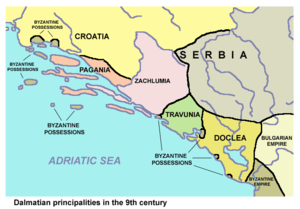Pomorje
Pomorje (Serbian Cyrillic: Поморје) or Primorje (Serbian Cyrillic: Приморје), also known as Littoral Serbia (Serbian: Приморска Србија / Primrska Srbija; Latin: Serbia Maritima)[1] and Seaside, is a term (literary meaning: maritime, littoral or coastland) used in historical contexts to designate a geographical region of several territories of Upper Dalmatia and its hinterland, belonging to the present-day Montenegro, Bosnia and Herzegovina and Croatia, settled by Slavs.

History
At the beginning of the 9th century, according to 822 entry of Einhard's Royal Frankish Annals, Serbs were ruling over "the greater part of Dalmatia"[2][3] (ad Sorabos, quae natio magnam Dalmatiae partem obtinere dicitur).[4] The state of maritime regions in the Early Middle Ages was described in the De Administrando Imperio,[5] a work by Byzantine Emperor Constantine VII (l. 905-959) dedicated to his son, Romanus II, as a domestic and foreign policy manual.
Pomorje included most of the coastal regions of modern-day Montenegro, the southern regions of Bosnia and Herzegovina, notably most of Herzegovina region, and a southeastern part of region Dalmatia in Croatia.[6]
Use in royal titles
The term was used in royal and religious titles both by Bosnian and Serbian monarchs and their heirs (Uroš I, styled himself "King in Christ, God faithful, King of Serbia and Maritime Lands", and Patriarchs (Saint Sava III, "Archbishop of All Serbian and Maritime Lands").
- Desa, styled himself "Prince of Pomorje (Maritime Lands)"
- Vladislav, styled himself "King of all the Serbian and Maritime Lands"
- Uroš I, styled himself "King in Christ, God faithful, King of Serbia and Maritime Lands"
- Uroš IV Dušan, "King of all the Serbian and Maritime Lands"
- 1329 Stephen II, Ban of Bosnia, styled "high and mighty lord, free ruler and master of Bosnia, Usora and Soli, Donji Kraji and many other places, and Prince of the Hum and the Seaside"
- 1377 Tvrtko I crowned himself King of "Serbia, Bosnia, Primorje, and the Western lands."
References
- Јанковић 2007.
- Einhard (1845). Einhardi Annales. Hahn. pp. 83–.
ad Sorabos, quae natio magnam Dalmatiae partem obtinere dicitur
- Scholz 1970, p. 111.
- Pertz 1845, p. 83.
- Moravcsik 1967.
- Nevill Forbes, The Balkans: A History of Bulgaria, Serbia, Greece, Rumania, Turkey, p. 59, Digital Antiquaria, 2004, ISBN 1-58057-314-2, ISBN 978-1-58057-314-6
Sources
- Primary sources
- Moravcsik, Gyula, ed. (1967) [1949]. Constantine Porphyrogenitus: De Administrando Imperio (2nd revised ed.). Washington D.C.: Dumbarton Oaks Center for Byzantine Studies.CS1 maint: ref=harv (link)
- Pertz, Georg Heinrich, ed. (1845). Einhardi Annales. Hanover.CS1 maint: ref=harv (link)
- Scholz, Bernhard Walter, ed. (1970). Carolingian Chronicles: Royal Frankish Annals and Nithard's Histories. University of Michigan Press.CS1 maint: ref=harv (link)
- Шишић, Фердо, ed. (1928). Летопис Попа Дукљанина (Chronicle of the Priest of Duklja). Београд-Загреб: Српска краљевска академија.CS1 maint: ref=harv (link)
- Кунчер, Драгана (2009). Gesta Regum Sclavorum. 1. Београд-Никшић: Историјски институт, Манастир Острог.CS1 maint: ref=harv (link)
- Живковић, Тибор (2009). Gesta Regum Sclavorum. 2. Београд-Никшић: Историјски институт, Манастир Острог.CS1 maint: ref=harv (link)
- Secondary sources
- Ćirković, Sima (2004). The Serbs. Malden: Blackwell Publishing.CS1 maint: ref=harv (link)
- Curta, Florin (2006). Southeastern Europe in the Middle Ages, 500–1250. Cambridge: Cambridge University Press.CS1 maint: ref=harv (link)
- Fine, John Van Antwerp Jr. (1991) [1983]. The Early Medieval Balkans: A Critical Survey from the Sixth to the Late Twelfth Century. Ann Arbor, Michigan: University of Michigan Press.CS1 maint: ref=harv (link)
- Fine, John Van Antwerp Jr. (1994) [1987]. The Late Medieval Balkans: A Critical Survey from the Late Twelfth Century to the Ottoman Conquest. Ann Arbor, Michigan: University of Michigan Press.CS1 maint: ref=harv (link)
- Fine, John Van Antwerp Jr. (2005). When Ethnicity Did Not Matter in the Balkans: A Study of Identity in Pre-Nationalist Croatia, Dalmatia, and Slavonia in the Medieval and Early-Modern Periods. Ann Arbor, Michigan: University of Michigan Press.CS1 maint: ref=harv (link)
- Hupchick, Dennis P. (2002). The Balkans: From Constantinople to Communism. New York: Palgrave.CS1 maint: ref=harv (link)
- Hupchick, Dennis P. (2017). The Bulgarian-Byzantine Wars for Early Medieval Balkan Hegemony: Silver-Lined Skulls and Blinded Armies. New York: Springer.CS1 maint: ref=harv (link)
- Janković, Đorđe (2004). "The Slavs in the 6th Century North Illyricum". Гласник Српског археолошког друштва. 20: 39–61.CS1 maint: ref=harv (link)
- Јанковић, Ђорђе (2007). Српско Поморје од 7. до 10. столећа (Serbian Maritime from 7th to 10th Century) (PDF). Београд: Српско археолошко друштво.CS1 maint: ref=harv (link)
- Luttwak, Edward N. (2009). The Grand Strategy of the Byzantine Empire. Harvard University Press.CS1 maint: ref=harv (link)
- Orbini, Mauro (1601). Il Regno de gli Slavi hoggi corrottamente detti Schiavoni. Pesaro: Apresso Girolamo Concordia.CS1 maint: ref=harv (link)
- Орбин, Мавро (1968). Краљевство Словена. Београд: Српска књижевна задруга.CS1 maint: ref=harv (link)
- Ostrogorsky, George (1956). History of the Byzantine State. Oxford: Basil Blackwell.CS1 maint: ref=harv (link)
- Runciman, Steven (1988). The Emperor Romanus Lecapenus and His Reign: A Study of Tenth-Century Byzantium. Cambridge University Press.CS1 maint: ref=harv (link)
- Sedlar, Jean W. (1994). East Central Europe in the Middle Ages, 1000-1500. Seattle: University of Washington Press.CS1 maint: ref=harv (link)
- Stephenson, Paul (2003). The Legend of Basil the Bulgar-Slayer. Cambridge: Cambridge University Press.CS1 maint: ref=harv (link)
- Тошић, Ђуро (2005). "Требињци и Захумљани у средњовјековном Котору". Истраживања: Филозофски факултет у Новом Саду. 16: 221–227.CS1 maint: ref=harv (link)
- Vlasto, Alexis P. (1970). The Entry of the Slavs into Christendom: An Introduction to the Medieval History of the Slavs. Cambridge: Cambridge University Press.CS1 maint: ref=harv (link)
- Whittow, Mark (1996), The Making of Byzantium, 600–1025, MacMillan Press, ISBN 0-520-20496-4
- Живковић, Тибор (2002). Јужни Словени под византијском влашћу 600-1025 (South Slavs under the Byzantine Rule 600-1025). Београд: Историјски институт САНУ, Службени гласник.CS1 maint: ref=harv (link)
- Živković, Tibor (2008). Forging unity: The South Slavs between East and West 550-1150. Belgrade: The Institute of History, Čigoja štampa.CS1 maint: ref=harv (link)
Further reading
- Ćorović, Vladimir (2001). "Istorija srpskog naroda".CS1 maint: ref=harv (link)
- Janković, Đorđe (2007). "Serbian Maritime from 7th to 10th Century: Summary of the Monograph".CS1 maint: ref=harv (link)